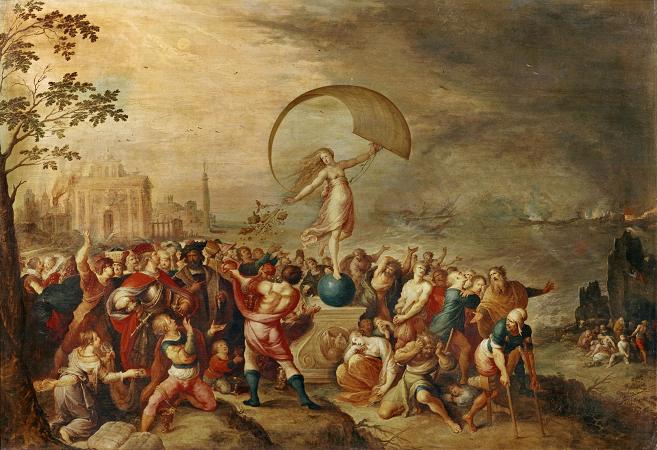Hieronymus Francken II (1578 - 1623). Hieronymus Francken the Younger or Hieronymus II was a Flemish painter and one of the most prominent members of the large Francken family of artists. Along with his brother Frans Francken II he played an important role in the development of new genres in Flemish art in the early 17th century. Hieronymus Francken II was the son of Elisabeth Mertens and Frans Francken the Elder. His father was a painter born in Herentals who had moved with his painter father to Antwerp. There he had become one of the principal painters during the Counter-Reformation. Hieronymus had three brothers who were painters: Thomas, Frans II and Ambrosius II. Hieronymus received his first training from his father. He was entered into the books of the Antwerp Guild of Saint Luke in 1605 as a pupil of his uncle Ambrosius. Ambrosius Francken I had trained with Frans Floris and had worked some time in Fontainebleau. In 1607 Hieronymus Francken II was formally admitted as a master of the Antwerp Guild. In 1609 he likely spent time in Paris, where like his brother Frans II, he may have studied under his uncle Hieronymus Francken I. Hieronymus Francken I worked most of his career in Paris and Fontainebleau and was a court painter to the French court from 1594. Hieronymus Francken II returned to Antwerp where he spent the rest of his career. From 1616/17 he worked as ionckmann in the house of his father Frans Francken I. Hieronymus Francken the Younger was a versatile artist who practised in many genres. Hieronymus painted art galleries and Kunstkammer, genre scenes of elegant balls and dances, history paintings, monkey scenes, allegorical paintings and still lifes. He also copied some of the scenes of witches and witchcraft, including portrayals of witches' sabbats, invented by his brother Frans II. As the paintings of various members of the Francken family were so similar in style and they rarely signed their work, it has been difficult for a long time to identify the works by Hieronymus II. In particular the works of Hieronymus II and Frans II have been difficult to distinguish as they had a similar training and worked in close proximity and as a result their figure style and subject matter is very similar. Various works of Hieronymus II were in the past attributed to his brother. On the basis of the few signed works by his hand historians have been able to reconstruct Hieronymus' oeuvre and re-attribute to him a number of works. Typical characteristics of Hieronymus' work are the use of broad brush strokes and earth colours, such as brick-red and variations of brown tones. The scale of his figures is occasionally awkward. Hieronymus as well as his brother Frans the Younger created many paintings depicting elegant balls. They typically represent anonymous events where couples or larger groups of elegant persons are dancing on music in an interior. It is possible that the brothers developed this subject under the influence of their uncle Hieronymus Francken I under whom they may have studied briefly during a presumed residence in Paris. Hieronymus I had developed this genre of elegant balls while working for the French court in Fontainebleau and Paris. The execution of these works by both brothers is similar in style. The architecture in these paintings was occasionally the work of another painter such as Paul Vredeman de Vries in the case of the work Elegant company in the Kunsthistorisches Museum. Some of the most original work of Hieronymus II was in the area of still lifes. He specialized in monochrome banquet still lifes typically of simple food and pottery. Gradually an oeuvre is being ascribed to him on the basis of his sole signed still life referred to as Still life with pottery, herring and pancakes, a print of an owl on the wall or Rich and the Poor at Table in the collection of the Royal Museum of Fine Arts Antwerp dated 1604. Another still life in the Royal Museum of Fine Arts Antwerp referred to as the Poor Man's Meal has been attributed to Hieronymus II. A very similar work was sold at Christie's on 17 May 2004 in Amsterdam as lot 72. There exists a third similar work in a private collection. It is believed that this composition Poor Man's Meal is a pendant to a composition representing a Rich Man's Meal of which there is only one copy preserved in a private collection. Frans Francken the Younger and Jan Brueghel the Elder were the first artists to create paintings of art and curiosity collections in the 1620s. Gallery paintings depict large rooms in which many paintings and other precious items are displayed in elegant surroundings. The earliest works in this genre depicted art objects together with other items such as scientific instruments or peculiar natural specimens.
more...













